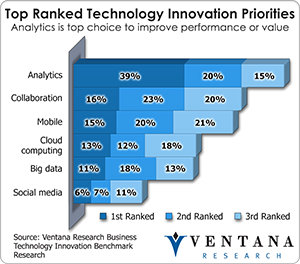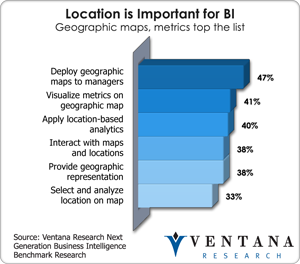 Business analytics have become mainstream in most
organizations. Our latest research in technology innovation found
analytics was the top-ranked technology in 39 percent of organizations.
To deepen
the sophistication of their analytics, businesses can add geographic
context and maps to business intelligence applications to create what we
call location intelligence. Applications and tools with a geographic
and spatial context can help deliver new and deeper insights to
business. Information about location or geography can improve the
quality of actions, decisions and responses to opportunities, and enable
organizations to understand more about their customers. It also can
help companies gain critical business insights, make better decisions
and optimize performance and processes. It can benefit marketing,
customer acquisition and retention efforts; logistics and supply chain
management; and financial and operational decisions, especially about
where to place retail outlets, business assets and people in various
functions.
Business analytics have become mainstream in most
organizations. Our latest research in technology innovation found
analytics was the top-ranked technology in 39 percent of organizations.
To deepen
the sophistication of their analytics, businesses can add geographic
context and maps to business intelligence applications to create what we
call location intelligence. Applications and tools with a geographic
and spatial context can help deliver new and deeper insights to
business. Information about location or geography can improve the
quality of actions, decisions and responses to opportunities, and enable
organizations to understand more about their customers. It also can
help companies gain critical business insights, make better decisions
and optimize performance and processes. It can benefit marketing,
customer acquisition and retention efforts; logistics and supply chain
management; and financial and operational decisions, especially about
where to place retail outlets, business assets and people in various
functions.While location analytics is not new, the heightened interest in actually doing something about it is, driven in part by the prevalence of mobile devices used for business and by the growing ability to analyze social media commentary and other expressions of customer sentiment.
Analysts across lines of business can gain more precise context and insight from location analytics to share with business professionals. Its use can support consumers’ growing expectation of the availability of location-related information in their interactions with business and as part of their self-service access to information and applications. Location data can be made available to any role in an organization that needs it. Using just the geographic context of the analytics can help businesses align customers with the right individual or location for immediate service, either manually or through the use of automated workflow. Our research into operational intelligence found that using geographic or location context as part of analyzing relationships of events is important to 32 percent of organizations. By using this technology effectively, companies can save time and money, reduce business risk and increase profitability and competitive advantage.
 Location analytics can complement your existing business intelligence (BI) or
business analytics efforts. Our next-generation business
intelligence benchmark research examined the importance of location and
found that deployment of geographic maps was the most important benefit
in 47 percent of organizations. Location analytics can deploy maps
either by leveraging data and analytics within existing software or
operating in parallel with it and utilizing the underlying data
structures. For some organizations location analytics also should enrich
the value of existing data within information management efforts by
helping to facilitate geocoding or data quality efforts or providing new
data that can be used with existing applications or tools. Advancements
in the use of big data let business take advantage of a greater volume
and velocity of data, and offer organizations a chance to support a
wider range of business analytics and applications.
Location analytics can complement your existing business intelligence (BI) or
business analytics efforts. Our next-generation business
intelligence benchmark research examined the importance of location and
found that deployment of geographic maps was the most important benefit
in 47 percent of organizations. Location analytics can deploy maps
either by leveraging data and analytics within existing software or
operating in parallel with it and utilizing the underlying data
structures. For some organizations location analytics also should enrich
the value of existing data within information management efforts by
helping to facilitate geocoding or data quality efforts or providing new
data that can be used with existing applications or tools. Advancements
in the use of big data let business take advantage of a greater volume
and velocity of data, and offer organizations a chance to support a
wider range of business analytics and applications.Yet our research shows a lot of room for improvement when it comes to location analytics deployment. Only 12 percent of organizations capture location data and use it in analysis. Another 15 percent capture it but do not use it, while almost a third (31%) plan to capture and use it.
I recommend that organizations identify their information assets, business processes and customer-facing applications that collect or contain geographic and location data, as well as those that would benefit from having location analytics capabilities, and then explore options offered by new tools to improve their efficiency and effectiveness. My colleague Tony Cosentino has already pointed out that location analytics is essential to adding value of business analytics and a key factor in our big data research agenda for 2013. If you are interested in gaining more depth on this topic, participate in our location analytics research. Help us explore the best practices and benefits for those using it today, and identify what needs to be improved in the technology.
Original article






0 comments:
Post a Comment